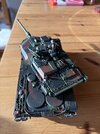AKRoast
Member
- Joined
- Oct 14, 2024
- Messages
- 74
Hi
Background: I have two models now where I used an Ammo acrylic primer, then a mix of AB Tamiya acrylics and hand painted details that are often done with Testors Enamel because I like the feel and coverage of it with a brush vs Tamiya acrylics with one. After that I AB on Vallejo acrylic gloss coat, apply decals, and AB on another gloss coat. The gloss coats seem pretty thick. I let dry a day between. I then use Tamiya oil based panel line/pin wash with their little built in brush.
Ok now the issue:
when I go back to wipe off excess wash, the wash has gotten thru the gloss coat and softened the enamel paint. If I then rub that detail, it smudges/roughens the enamel.
I had seen on YT that the gloss coat had to be acrylic so an oil based wash would not do that? And it had to be an oil based wash because the gloss coat and paint coats were mostly acrylics. Maybe I can't use any enamel paint for details in this scenario? Or maybe the Vallejo gloss coat is too weak? Maybe not enough drying time between steps?
Any opinions would be appreciated. Thanks
Background: I have two models now where I used an Ammo acrylic primer, then a mix of AB Tamiya acrylics and hand painted details that are often done with Testors Enamel because I like the feel and coverage of it with a brush vs Tamiya acrylics with one. After that I AB on Vallejo acrylic gloss coat, apply decals, and AB on another gloss coat. The gloss coats seem pretty thick. I let dry a day between. I then use Tamiya oil based panel line/pin wash with their little built in brush.
Ok now the issue:
when I go back to wipe off excess wash, the wash has gotten thru the gloss coat and softened the enamel paint. If I then rub that detail, it smudges/roughens the enamel.
I had seen on YT that the gloss coat had to be acrylic so an oil based wash would not do that? And it had to be an oil based wash because the gloss coat and paint coats were mostly acrylics. Maybe I can't use any enamel paint for details in this scenario? Or maybe the Vallejo gloss coat is too weak? Maybe not enough drying time between steps?
Any opinions would be appreciated. Thanks

